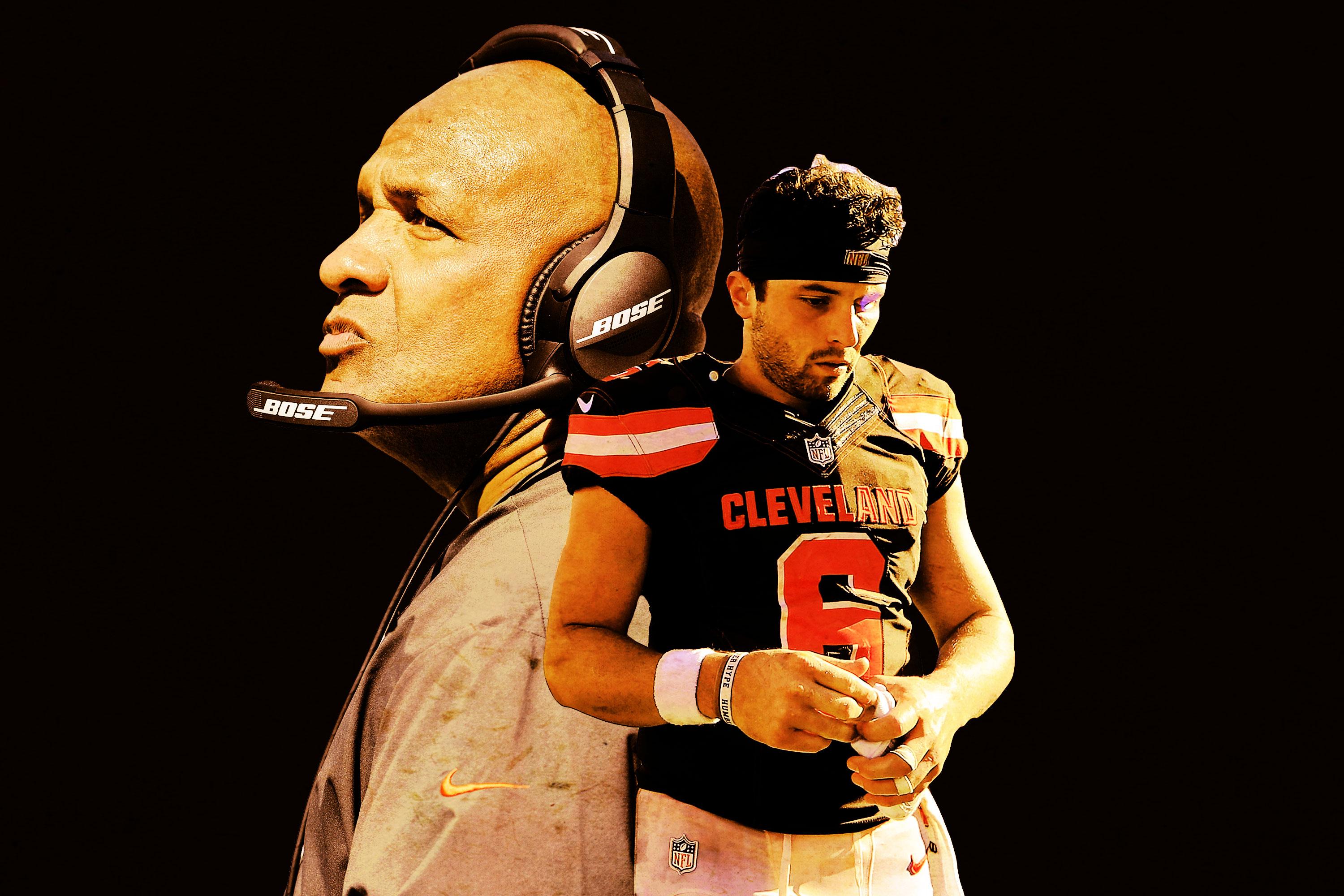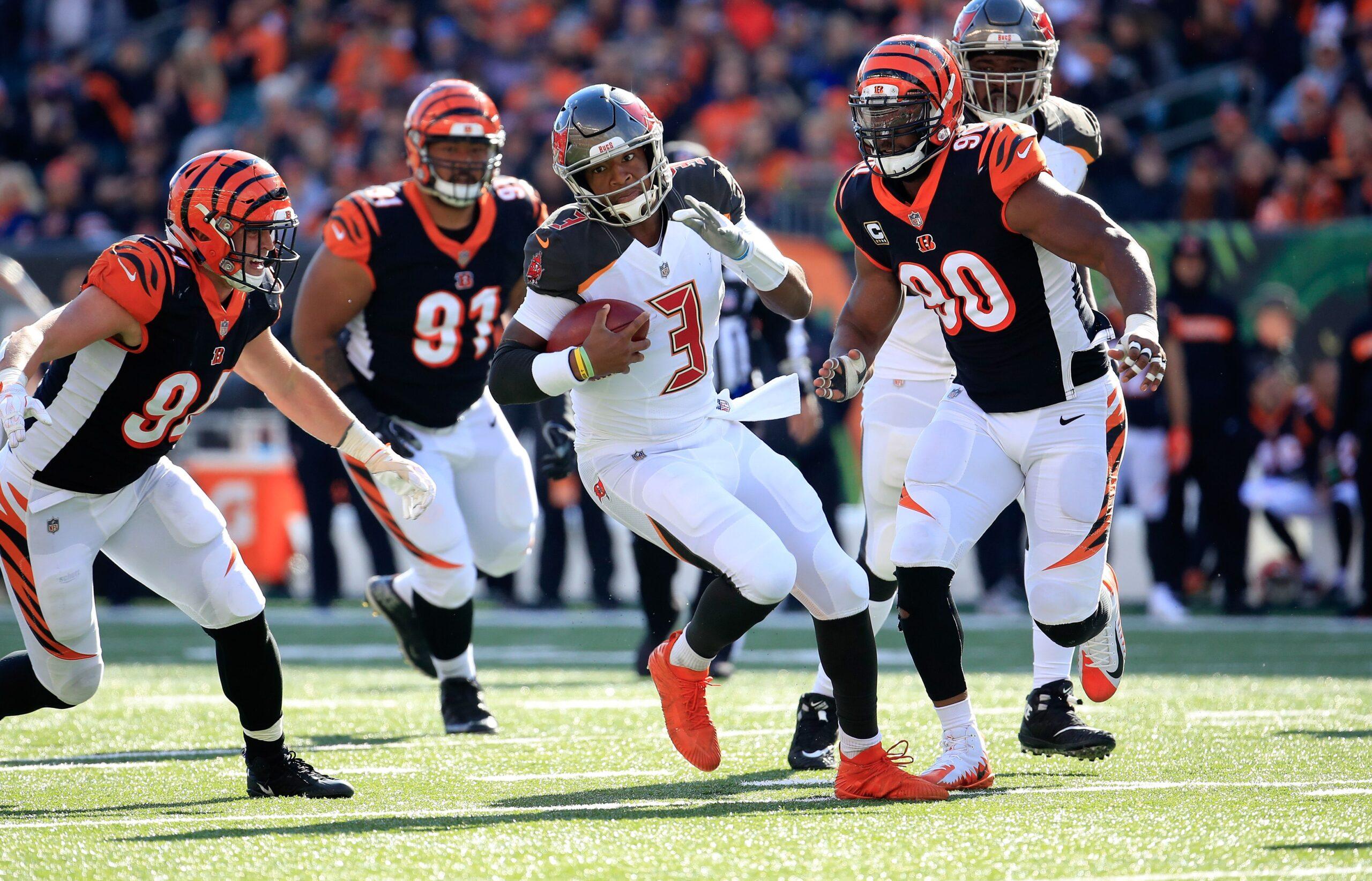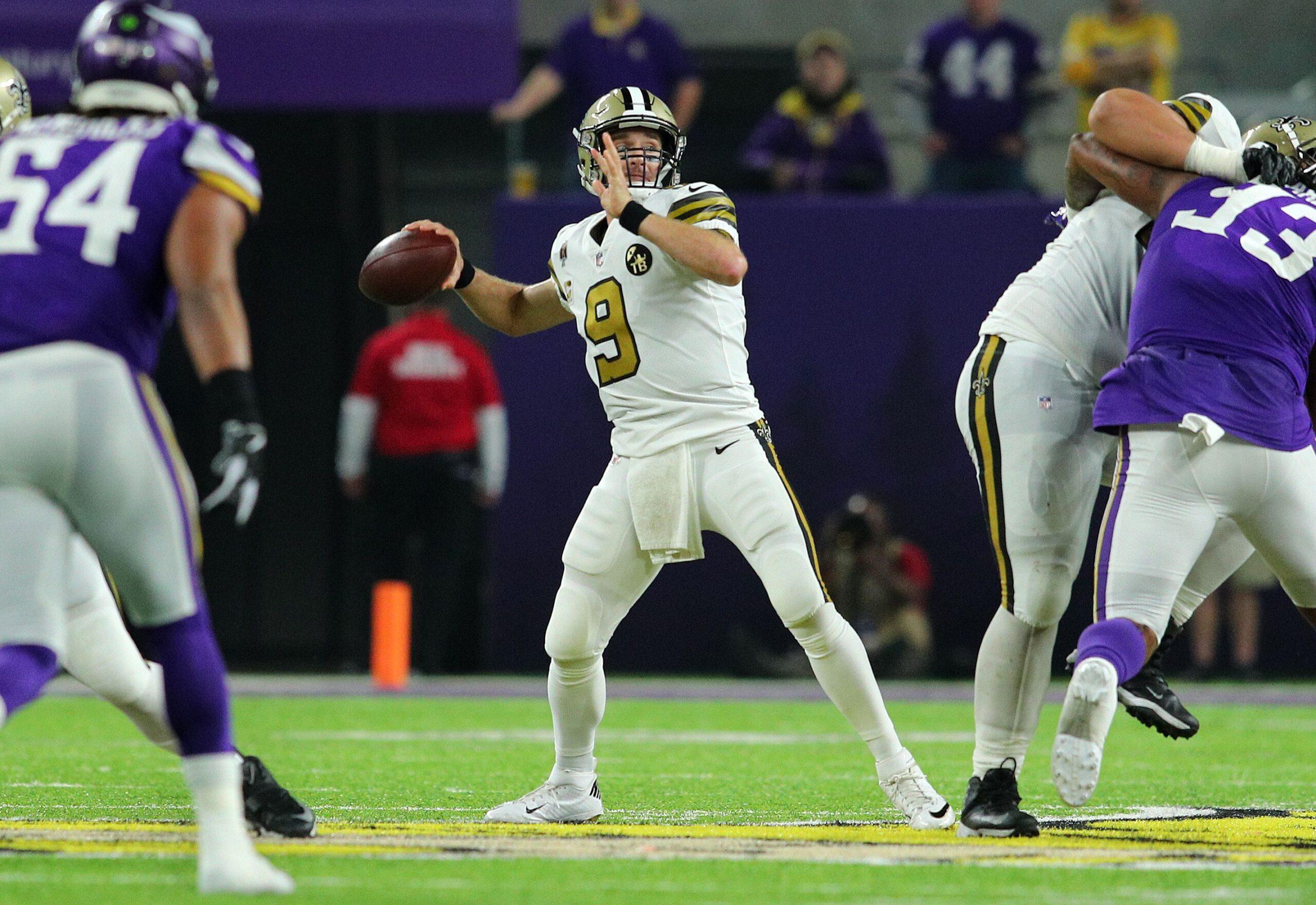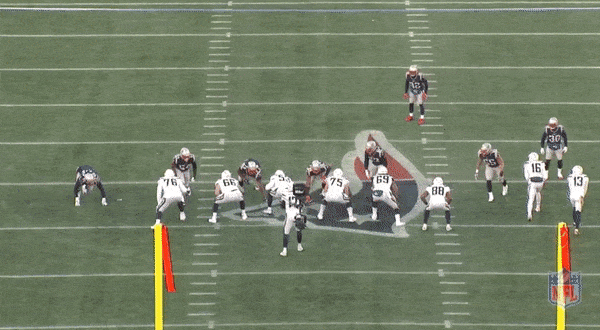The Starting 11: Hue Jackson Has Lost His Last Game With the Browns. So What’s Next for Cleveland?
The Browns fired their head coach on Monday, ending an era that was defined by losing, lake jumps, and more losing. Now, it’s time to figure out who Baker Mayfield’s next coach will be. Plus: The Jameis Winston era may be over in Tampa Bay, and Russell Wilson continues his hot streak.
Welcome to the Starting 11. This NFL season, we’ll be collecting the biggest story lines, highlighting the standout players, and featuring the most jaw-dropping feats of the week. Let’s dive in:
1. The Hue Jackson era is finally over with the Browns, and the biggest remaining question is: How did it take this long? It became clear last week that something had to give in Cleveland. As the tension between Jackson and offensive coordinator Todd Haley mounted, the whisper campaigns and power struggles began. It was like watching Game of Thrones, except everyone involved was incompetent and the ultimate prize was the right to coach a last-place team for eight more games. Instead of choosing between Jackson and Haley, owner Jimmy Haslam and general manager John Dorsey fired them both and named defensive coordinator Gregg Williams interim head coach. “Gregg Williams, head coach” is a legitimately terrifying thought in 2018, but let’s not get stuck on that. With Jackson gone, the time to speculate about who’ll become the Browns’ 10th coach in 19 years has arrived.
Before throwing out some names, though, I want to take a moment to ask why any of this was even necessary. Earlier this year, the Browns hired a new GM and had the first overall pick in the draft, which they were expected to spend on a franchise quarterback. Jackson had gone 1–31 over his first two seasons, and even if you believed the Sashi Brown experiment had hindered Jackson’s on-field product, there was zero evidence that he’d be the right man to helm the next generation of this team. Cleveland had a chance to wipe the slate clean and usher in a new day for the franchise; instead, it allowed one of the precious few years of quarterback Baker Mayfield’s rookie contract to essentially go to waste.
Dorsey spent last offseason making aggressive trades and using the high-end picks accrued during Sashi Brown’s tenure to build a talented roster. Now, the Browns have a league-best plus-11 turnover differential, and Myles Garrett and Denzel Ward have become two of the most exciting young defenders in football. There’s plenty to work with, and we’ll see if that collection of players and the chance to work with Mayfield is enough to lure a coach to what hasn’t historically been an enticing job.
Cultivating their young quarterback has to be at the top of Haslam and Dorsey’s priority list. Over the past few seasons, we’ve seen what offensive-minded coaching hires can do for QBs in their second season. Carson Wentz became an MVP candidate in Year 2 under Doug Pederson. Sean McVay turned Jared Goff from one of the worst rookie quarterbacks ever into in an excellent passer. After hiring Matt Nagy this offseason, the Bears are scoring 27.7 points per game with Mitchell Trubisky under center. Finding the right guy to unlock Mayfield should be the Browns’ ultimate motivation.
So, when looking at candidates to take over the job, the first name that comes to mind is obviously Oklahoma head coach Lincoln Riley. He’s already revered as a play-caller in the NFL community, and taking the Browns job would give him the chance to reunite with Mayfield, whom he coached for three seasons in college. Riley has said more than once that he has no interest in a pro coaching job right now, but that’s what the coach of a 7–1 team with its sights on a return to the College Football Playoff has to say. Riley’s deal in Norman is set to pay him an average of $5 million per season over the next five years. That’s a lot of money, but the NFL is a place where a coach like Jon Gruden can make $10 million a year. At least one team (whether it’s the Browns or someone else) is likely to make Riley an offer that’d be hard to turn down.
If the Riley pursuit doesn’t work out, another early name to consider would be Vikings offensive coordinator John DeFilippo. That could be a complicated reunion, considering DeFlippo’s one-year stint as the Browns OC in 2015 went so poorly (the team went 3–13 and the offense finished 27th in DVOA), but he was also a 37-year-old coach in his first year as a play-caller. After two years serving as the Eagles QB coach, he’s ascended back to an offensive coordinator role in Minnesota, and he’s been excellent this season. There are also plenty of dark-horse candidates whose names may emerge in the next couple months — after all, not many people knew McVay’s name in October 2015, during his final season in Washington before taking over the Rams. Whoever Dorsey and Haslam do pick, they better hope he can turn Mayfield into the quarterback that Dorsey envisions.
2. After throwing four interceptions and being benched in favor of Ryan Fitzpatrick in Sunday’s loss to the Bengals, it looks like the Jameis Winston era in Tampa Bay may be over. Winston has been a turnover-prone quarterback for years, but the Bucs expected to see some sort of progress in his fourth NFL season. Instead, Winston has thrown multiple interceptions in each of his three starts since returning from his three-game suspension. Fitzpatrick entered Sunday’s game late in the third quarter after Winston’s fourth pick (one that was returned for a touchdown), and he went 11 of 15 for 194 yards while engineering two touchdown drives to tie the game at 34–34 (the Bengals eventually won, 37–34). Even if yards are easier to come by when a team is down multiple scores in the second half, it’s pretty clear that the Bucs offense is better with Fitzpatrick calling the shots. He’s officially been named the team’s starting quarterback against Carolina this week, and that fact alone calls Winston’s future with the organization into question.

It’s difficult to rationalize paying a quarterback $21 million on his fifth-year option when that quarterback loses his starting job to a 35-year-old journeyman. And as Winston’s 2019 option is guaranteed only for injury, the Bucs can move on at no cost this spring if they choose. Winston’s history of off-field transgressions was already reason enough to wonder whether the Bucs should commit to him moving forward. Given his play so far this year, it’s pretty clear they shouldn’t. Tampa Bay could decide to move on from head coach Dirk Koetter at the end of this season — and possibly GM Jason Licht, too. If ownership decides to hang onto Winston for next season, they’ll be making a slightly altered version of the mistake Cleveland made this offseason by not pairing a new coaching staff and front office regime with an exciting quarterback.
This team is in a precarious spot. It has the rare combination of a front office that seems committed to winning now, and a team that looks ready to start over. The Bucs defense is certainly bad enough that this team could earn a top-10 pick — defensive coordinator Mike Smith was fired two weeks ago, but that didn’t seem to make much of a difference on Sunday. The Bengals scored four touchdowns in the first half, and each of those drives was horrifyingly easy. Watching Tampa Bay’s pass defense feels like viewing a 7-on-7 game. But with Fitzpatrick running the offense, there’s a chance that unit is just too good for the Bucs to fully bottom out. The Bucs are currently expected to have less than $13 million in cap space for 2019, which is why moving on from Winston and saving $21 million may be attractive. Finding a quarterback with a pick outside the top eight is historically difficult, but this is a team that would be well-served by moving up and getting their guy if they feel like it’s necessary. Even a cheaper stopgap option may be better for the Bucs long-term than bringing Winston back for one more run.
3. Russell Wilson’s huge day against the Lions was a reminder that he is still one of the best quarterbacks in football. Wilson threw for 248 yards with as many touchdowns (three) as incompletions in the Seahawks’ 28–14 win over Detroit on Sunday. Seattle’s game plan was built around running the ball and using play action, which worked to perfection against a leaky Lions defense. Wilson’s second-quarter touchdown throw to Tyler Lockett on a floater to the back corner of the end zone (which he threw while on the move) was the type of sorcery we’re used to seeing from him when he’s at his best.
With the massive improvements in Seattle’s offensive line under first-year position coach Mike Solari and the emergence of an actual rushing attack with running back Chris Carson (who had 25 carries for 105 yards on Sunday), the Seahawks’ offensive infrastructure has been much better this season compared to years past. But it’s not as if Wilson was throwing to wide open receivers all day against Detroit. Aside from a pair of deep shots to David Moore and Ed Dickson, many of Wilson’s completions on Sunday were into tight windows that required precise throws and great plays from his receivers. Offensive coordinator Brian Schottenheimer has been smart to lean on more play-action with one of the league’s best play-action quarterbacks, and the team had success with it again on Sunday: Wilson was 6-of-9 for 132 yards and one touchdown using play-action. If Wilson can continue to play like this, the Seahawks might become playoff-relevant down the stretch.
4. As they enter their bye week, it’s time for the Giants to consider sending Eli Manning to the bench. Another game, another unwatchable performance by the Giants offense. Big Blue was just the latest team to have its running game completely shut down by Washington, which left the Giants to try and generate production with passes to Odell Beckham Jr., dump offs to Saquon Barkley, and not much else. Manning finished the game 30 of 47 with two interceptions in yet another underwhelming performance as his team lost 20–13. The Giants’ struggles on offense aren’t entirely Manning’s fault. He was sacked seven times against Washington, and two of those sacks occurred less than 2.5 seconds after the snap, according to Pro Football Focus. Manning has taken 12 such sacks this season. No other quarterback has taken more than seven. The team’s offensive line has been a nightmare, but sitting at 1–7 in what is likely Manning’s final season with the franchise, it’s worth at least exploring what the team has in rookie quarterback Kyle Lauletta. Other than deference to a quarterback who won the team two Super Bowls, there’s no real argument for sticking with Manning at this point.
5. Adrian Peterson had a vintage 149-yard game, and his performance was a key component of what’s becoming a winning formula for Washington. The Redskins handed Peterson the ball 26 times in their 20–13 win, and he rewarded them with a monster day. Peterson was the Washington offense on Sunday; his 64-yard run to cap the game looked straight like it came out of film from 2012, which is amazing considering he couldn’t find a team to sign him until late August. It took rookie running back Derrius Guice tearing his ACL for Peterson to even find a job, and in seven games he’s rushed for 587 yards with a 4.6 yards per carry average. It’s certainly possible that the 33-year-old will slow down as the season progresses (just look at how hot he started in Arizona last season before tailing off), but if he does keep a similar pace for the rest of the year, Peterson would finish with more than 1,300 yards rushing. That would give him over 13,500 yards for his career, which would move him ahead of Eric Dickerson for eighth on the all-time rushing list, just behind both Jerome Bettis and LaDainian Tomlinson. He’s already sixth all time in rushing touchdowns with 103, and with two more he’ll pass Redskins legend John Riggins.
Peterson doesn’t need more arbitrary statistical benchmarks to get to Canton. He’s already headed there. Among players in the top 10 of the all-time rushing list, only Barry Sanders has a higher career yards-per-carry number and averaged more yards per game. Playing this well at Peterson’s age is almost unheard of. Riggins is the only player since the merger to rush for more than 1,300 yards in his age-33 season or later, and he failed to crack 4.0 yards per carry. The last player 33 years or older to run for a touchdown of at least 64 yards was Jim Thorpe — in 1921. This would be an incredible final flourish from a player who was already the best running back of his generation.
Part of the reason Peterson’s season has been so notable is that he’s helped Washington get off to a 5–2 start. The Redskins have built a team around their defensive line and running game. They’re constructed to win games 20–17, and while that almost certainly isn’t sustainable in 2018, it’s worked so far! This team may be destined for a loss in the wild-card round after winning a mediocre (at best) NFC East, but not before they eek out a few games in ugly fashion.
6. The Saints had their own ugly win on Sunday night, which for them might actually be encouraging. New Orleans managed to beat the Vikings 30–20 in a game where Drew Brees threw for 120 yards. It was by no means a bad day for Brees. He threw his first interception of the season, which came when he was hit by Stephen Weatherly as he released the throw, but the Saints were relatively efficient when they put the ball in the air. The nice part for Brees was they didn’t have to air it out very often. A pair of crucial takeaways by the Saints defense — including a pick-six by cornerback P.J. Williams to give New Orleans a 14-point lead late in the third quarter — kept the Vikings offense at bay and allowed Brees to take a back seat.

With injuries and declines in performance ravaging the secondary, this New Orleans defense isn’t suddenly turning into the unit it was last season. No team that trades for Eli Apple midseason is headed anywhere good. The Vikings still marched up and down the field while Adam Thielen and Stefon Diggs picked on every cornerback not named Marshon Lattimore. The only things capable of slowing Minnesota down were the crumbling pockets Kirk Cousins experienced on about half his dropbacks and a pair of turnovers. But that’s pretty telling. The Saints’ best hope this season is for Dennis Allen’s defense to be high variance like it was during some of the best years of the Brees era. A few scattered big plays, combined with one of the league’s best offenses, is probably the team’s best recipe for a deep playoff run.
7. Carolina continued its winning ways on Sunday, beating the Ravens 36–21, and that game was more proof that this Panthers team is different from the ones we saw the past two seasons. For the most part, the major pieces of the Panthers’ franchise have been in place for years. Ron Rivera is in his eighth season. The same goes for Cam Newton. Luke Kuechly arrived one year after those two. But for the past few seasons following their surprising 15–1 season and Super Bowl run in 2015, it felt like the Panthers had regressed into a solid but uninspiring team that belonged a step below the contenders in the NFC. And heading into this season, it didn’t seem like any of their offseason additions would be enough to shock them out of their station. Well, I might have been wrong.
The Panthers’ offseason tweaks seemed marginal at best (drafting D.J. Moore in the first round) and harmful at worst (hiring Norv Turner as the team’s offensive coordinator), but both have given new dimensions to this offense. Newton is completing 66.4 percent of his passes in one of the most efficient seasons of his career for an offense that ranks 12th in the NFL in points per game. Turner’s scheme has been shockingly innovative for a coach who was out of football last season; it’s featured tons of motion, play-action throws, and unique run designs, and Moore has been a part of it all. Along with his 90 receiving yards on Sunday, Moore added two rushes for 39 yards — one on a two-back pitch design (that he nearly fumbled) and another on a reverse flip from Newton. Turner has consistently found ways to get the ball in the hands of his shifty playmakers, and it’s given the Panthers offense new life while lessening the burden on Newton.
8. It may seem strange to celebrate a quarterback who led his team to three points in three quarters, but there was plenty to like about Josh Rosen’s performance in the Cardinals’ 18–15 comeback win over the Niners. For rookie quarterbacks, sustained success is tough to come by. Most players thrust into action as rookies are highly drafted players walking into rough situations. Rosen is no different; Arizona’s receiving corps lacks talent, the offensive line needs major work, and the team fired its offensive coordinator a week ago. Rosen is going to have his struggles in those surroundings.
What is important to see from young quarterbacks, though, are encouraging moments, and Rosen has had at least a couple in each of his starts. His 37-yard completion to Larry Fitzgerald early in the fourth quarter on Sunday featured pocket awareness well beyond his years. His best plays as a rookie have all shown a knack for navigating a crowded pocket without bailing out, all while keeping his eyes downfield. Rosen demonstrated that on a third-and-10 in the fourth quarter: He drifted to his right to find a clean window, all while staying in the pocket, and threw a strike to Fitzgerald for a first down. It’s going to be a rough season for the Cardinals — and, at times, for Rosen — but there’s plenty there to get excited about.
9. The Niners, on the other hand, haven’t seen that type of development from their young cornerstones. The moment Jimmy Garoppolo went down with an ACL injury in Week 3, San Francisco’s season was lost. But it would still be nice to see some progress from their young, highly drafted players. Solomon Thomas has been a disappointment in his first two seasons. Third-round pick Ahkello Witherspoon has been unplayable at times during his second season. Outside of splash plays from Fred Warner and Reuben Foster, there just hasn’t been much to like from the 49ers’ young defensive core. First-round tackle Mike McGlinchey looks like a hit on the right side, but his contributions alone aren’t enough to consider this year a success by any measure. Injuries sabotaged this season for San Francisco, and Kyle Shanahan remains of the best offensive coaches in football. But for a year that started off with so much hope, the results have been disheartening.
10. This week’s line-play moment that made me hit rewind: Dee Ford picked up three more sacks against the Broncos, and he’s been a wrecking ball for the Chiefs this season. Ford brought his season sack total to eight on Sunday while adding two forced fumbles, neither of which were cheap, late-in-the-down strip sacks to pad his numbers. Ford toasted both Broncos tackles, using a speed rush with impressive bend around the edge to work back toward Case Keenum. In a contract year, Ford is playing the best football of his career. According to PFF, Ford leads the league in QB pressures (44) and ranks second behind only Jerry Hughes in pass-rush productivity. With an embattled secondary behind him, Ford has given the Chiefs defense the kind of game-swinging plays they need.

11. This week in NFL players, they’re absolutely nothing like us: I don’t care that it didn’t count: DeAndre Hopkins’s absurd catch on Thursday night was one of the best I’ve ever seen.